change time PONTIAC FIREBIRD 1997 Owners Manual
[x] Cancel search | Manufacturer: PONTIAC, Model Year: 1997, Model line: FIREBIRD, Model: PONTIAC FIREBIRD 1997Pages: 410, PDF Size: 19.2 MB
Page 3 of 410
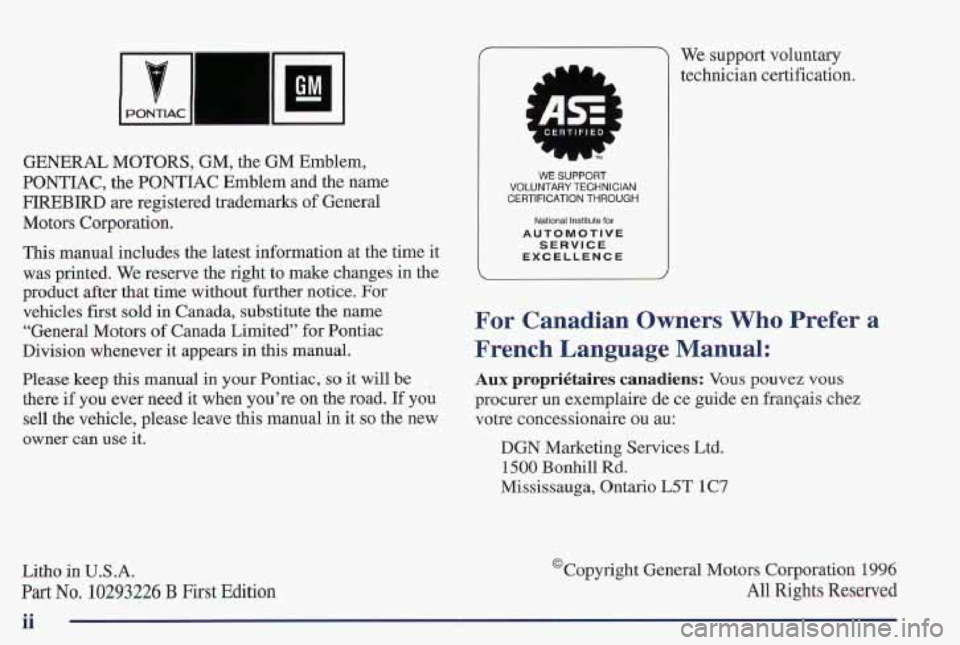
I
GENERAL MOTORS, GM, the GM Emblem,
PONTIAC,
the PONTIAC Emblem and the name
FIREBIRD are registered trademarks of General
Motors Corporation.
This manual includes the latest information at the time it
was printed.
We reserve the right to make changes in the
product after that time without further notice. For
vehicles first sold in Canada, substitute the name
“General Motors
of Canada Limited” for Pontiac
Division whenever it appears in this manual.
Please keep this manual in your Pontiac,
so it will be
there if you ever need it when you’re on the road. If you
sell the vehicle, please leave this manual in it so the new
owner can
use it.
Litho in U.S.A.
Part No. 10293226 B First Edition
WE SUPPORT VOLUNTARY TECHNICIAN CERTIFICATION THROUGH
AUTOMOTIVE
National institute for
SERVICE EXCELLENCE
We support voluntary
technician certification.
For Canadian Owners Who Prefer a
French Language Manual:
Aux propri6taires canadiens: Vous pouvez vous
procurer un exemplaire de ce guide en frangais chez
votre concessionaire ou au:
DGN Marketing Services Ltd.
1500 Bonhill Rd.
Mississauga, Ontario L5T 1C7
@Copyright General Motors Corporation 1996
All Rights Reserved
Page 58 of 410
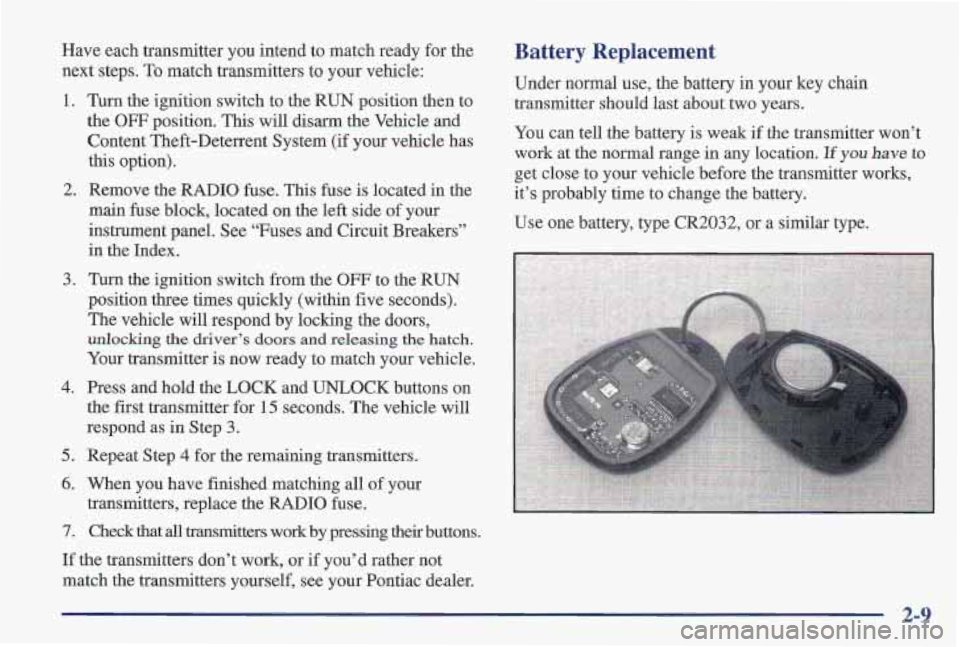
Have each transmitter you intend to match ready for the
next steps. To match transmitters to your vehicle:
1. Turn the ignition switch to the RUN position then to
the
OFF position. This will disarm the Vehicle and
Content Theft-Deterrent System (if your vehicle has
this option).
2. Remove the RADIO fuse. This fuse is located in the
main fuse block, located on the left side of your
instrument panel. See “Fuses and Circuit Breakers”
in the Index.
3. Turn the ignition switch from the OFF to the RUN
position three times quickly (within five seconds).
The vehicle will respond by locking the doors,
unlocking the driver’s doors and releasing the hatch.
Your transmitter is now ready to match your vehicle.
4. Press and hold the LOCK and UNLOCK buttons on
the first transmitter for 15 seconds. The vehicle will
respond as in Step
3.
5. Repeat Step 4 for the remaining transmitters.
6. When you have finished matching all of your
7. Check that all transmitters work by pressing their buttons.
transmitters,
replace the
RADIO fuse.
If the transmitters don’t work, or if you’d rather not
match the transmitters yourself,
see your Pontiac dealer.
Battery Replacement
Under normal use, the battery in your key chain
transmitter should last about two years.
You can tell the battery is weak if the transmitter won’t
work at the normal range in any location.
If you have to
get close to your vehicle before the transmitter works,
it’s probably time to change the battery.
Use one battery, type
CR2032, or a similar type.
2-9
Page 69 of 410

Mode 1: All Off (The headlamps will not flash and the
horn will not sound
to provide you feedback that a
lock/ud~& command has been received by the Remote
Lock Control transmitter).
Mode 2: Horn and LampdLamps (Your horn will sound
briefly and your parking lamps will flash when you
press
LOCK on the key chain transmitter. Only your
parking lamps will flash when you press
UNLOCK).
Mode 3: Horn and Lamps (Your horn will sound briefly
and your parking lamps will flash every time you push
LOCK and
UNLOCK).
Mode 4: Lamps (Your parking lamps will flash every
time
you push LOCK and UNLOCK),
Mode 5: Lamps/Horn and Lamps/Lamps (Your
lamps will flash
upon the first push on LOCK, your
lamps will flask and
your horn will sound upon the
second push on
LOCK and your lamps will flash upon
any push on
UNLOCK).
Theft-Detlerrent Arming Method
Your vehicle comes with this feature set in Mode 3. This
means that both your key chain transmitter and the
power door lock switch will actively arm the system.
To
change the factory setting, do the following:
1. Press the UNLOCK switch on the door.
2. Count the number of chimes you hear. The number of
chimes tells you which mode your vehicle is set for,
3. Press the UNLOCK switch on the door until you
hear the number
of chimes that correspond to the
mode selection
you want.
Mode I: Alarm System Off (The system will not arm).
Mode 2: Key Chain Transmitter Lock (When you lock
your doors using the Key Chain Transmitter, the system
will arm itself).
Mode 3: Key Chain TransmittedPower Door Lock
Switch
(If you use either the Key Chain Transmitter or
the power door
lock switch to lock the doors, the system
will arm itself).
Mode 4: Passive arming and Remote Lock Control
Transmitter/Power Door Lock Switch Arming
(The
system will arm itself after all doors are closed plus
arming per;mg&
3).
2-20
Page 75 of 410

Manual Transmission
The gear selector should be in NEUTRAL (N). Hold the
clutch pedal to the floor and start the engine. Your
vehicle won’t start if the clutch pedal
is not all the way
down
-- that’s a safety feature.
1. Without pushing the accelerator pedal, turn your
ignition key to START. When the engine starts, let
go of the key. The idle speed will go down as your
engine gets warm.
NOTICE:
Holding your key in START for longer than
15 seconds at a time will cause your battery to be
drained much sooner. And the excessive heat can
damage your starter motor.
2. If it doesn’t start right away, hold your key in
START for about three to five seconds at a time until
your engine starts. Wait about 15 seconds between
each try to help avoid draining your battery.
3. If your engine still won’t start (or starts but then stops),
it could be flooded with too much gasoline. Try
pushing
your accelerator pedal all the way to the floor and
holding it there as you hold the key
in START for about
three seconds.
If the vehicle starts briefly but then stops
again,
do the same thing, but this time keep the pedal
down for five or six seconds. This clears the extra
gasoline from the engine. After waiting about
15 seconds, repeat the normal starting procedure.
NOTICE:
Your engine is designed to work with the
electronics in your vehicle. If you add electrical
parts or accessories, you could change the way
the engine operates. Before adding electrical
equipment, check
with your dealer. If you don’t,
your engine might not perform properly.
If you ever have to have your vehicle towed, see
the part
of this manual that tells how to do it
without damaging your vehicle. See “Towing
Your Vehicle” in the Index.
2-26
Page 142 of 410

Air Conditioning (If Equipped)
I
The air conditioning system uses the same controls as
the heating system, except that the air control knob has
two extra settings, described below.
MAX: Provides maximum cooling or quick cool-down
on very hot days. This setting recirculates most of the air
inside your vehicle.
If it is used for long periods of time,
the air may become dry. This setting directs air through
the upper air vents,
A/C: Use for normal cooling on hot days. This setting
cools outside
air and c‘kts it through the upper air vents.
The i-111- conditioner cumpressor operates in MAX, AIC,
BI-LEVEL, BLEND and DEFROST when the outside
temperature is above freezing. When the
air conditioner
is on,
you may sometimes notice slight changes in
your vehicle’s engine speed and power. This is normal
because the system is designed to cycle the compressor
on and
off to keep the desired cooling and help
fuel economy.
Cooling
The air conditioner works best if you keep your
windows closed. On very
hot days, open the windows
just long enough for the hot air to escape.
1. Turn the air control knob to A/C for normal cooling.
For faster cooling, move the
knob to MAX.
2. Turn the temperature control knob to a
comfortable setting.
3. Move the fan control knob to the desired speed.
Page 155 of 410

RDM (3): Press this button to hear the tracks in random,
rather than sequential, order. The display will show
RDM. Pres,s RDM again to turn off random play.
REV (5): Press and hold this button to quickly reverse
within a track. Release it to play the passage.
You will
hear sound at a reduced volume. The display will show
elapsed time.
FWD (6): Press and hold this button to quickly advance
within a track.
You will hear sound at a reduced volume.
The display will show elapsed time.
RECALL: Press this button to see what track is
currently playing. Press RECALL again within five
seconds to
see how long the track has been playing.
When
a new track starts to play, the track number will
also appear. Press RECALL a third time and the time of
day will be displayed.
AM-FM: Press this button to play the radio when a disc
is playing. The disc will stop but remain in the player.
CDPLAY: Press this button to change to the disc
Function when the radio is on.
EJECT: Press this button to remove the dis'c or stop the
disc and switch to the radio. EJECT will work with the
radio
off. If you leave a compact disc in the player while
listening
to the radio, it may become warm.
Trunk Mounted CD Changer (If Equipped)
With the optional compact disc changer, you can play up
to 12 discs continuously. Normal size discs may be
played using the trays supplied in the magazine.
The small discs
(8 cm) can be played only with specially
designed trays.
You must first load the magazine with discs before you
can play a compact disc. Each of the
12 trays holds one
disc. Press the button
on the back of the magazine and
pull gently on one
of the trays. Load the trays from
bottom to top, placing a disc on the tray label side down.
If you. load a disc label side up, the disc will not play
and an error will occur, Gently push the tray
back into
the magazine slot. Repeat this procedure
for loading up
to 12 discs in the magazine.
Once you have loaded the
discs in the magazine, slide
open the door
of th'e compact disc (CD) changer. Push
the magazine into the changer in the direction of the
arrow marked on top of the magazine.
Close the door
by sliding it all the way to the left. If the
door is left partially open, the changer will not operate
and an error will occur. When the
door is closed, the
changer will begin checking for discs in the magazine,
This will continue for up to two minutes depending on
the number of discs loaded.
Page 157 of 410

Playing a Compact Disc
PREV
(1): Press this button to go back to the start of
the current track if more than eight seconds have played.
Press PREV again to go to the previous track
on
the disc.
NEXT (2): Press this button to advance to the next track
on the disc.
PROG (3): Press this button to select the next disc in
the magazine.
If a CD cannot be played, its number
will be skipped when selecting discs while using the
PROG button.
RANDOM (4): Press this button to enter the random
play mode.
RDM will appear on the display. While in
this mode, the tracks on the discs will be played in
random order.
If you press PRQG or SEEK while in the
random mode, discs and tracks will be scanned
randomly. Press this button again to turn
off the random
feature and return to normal operation.
REV (5): Press and hold this button to quickly reverse
within
a track. As the CD reverses, elapsed time will be
displayed to help you find the correct passage.
FWD (6): Press and hold this button to quickly advance
within
a track. As the CD advances, elapsed time will be
displayed to help you find the correct passage.
RECALL: Press this button to see what track is
currently playing. Press
RECALL again within five
seconds to see how long the track has been playing.
EL
TM will appear on the display when in elapsed time
mode. When a new track starts to play, the track number
will also appear.
Press RECALL a third time and the
time
of day will be displayed.
SEEK: Press the SEEK down arrow while playing a CD
to go back to the start of the current track if more than
eight seconds have played.
If you press it again, the
changer will
go to previous tracks. Press the SEEK up
arrow and it will go to the next higher track on the disc.
TAPERLAY: Press this button to play a CD if you
have
a magazine loaded in the changer and the radio is
playing.
To return to the radio while a CD is playing,
press
AM-FM. You can also press this button to switch
between
a cassette tape and CD, if both are loaded.
3-18
Page 173 of 410
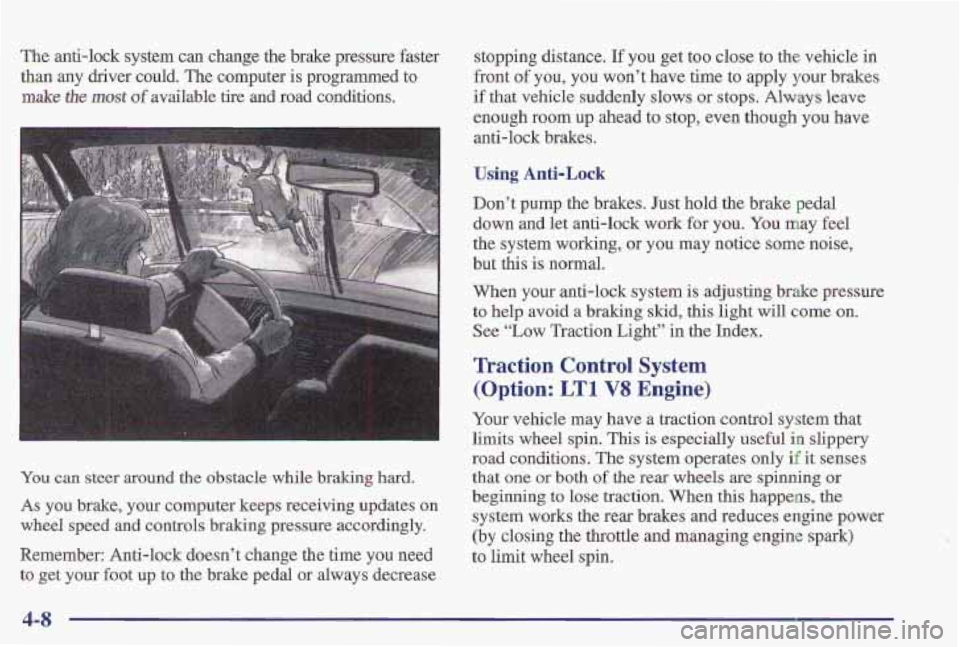
The anti-lock system can change the brake pressure faster
than any driver could. The computer is programmed to
make the most of available tire and road conditions.
You can steer around the obstacle while braking hard.
As you brake, your computer keeps receiving updates on
wheel speed and controls braking pressure accordingly.
Remember: Anti-lock doesn’t change the time
you need
to get your foot up to the brake pedal or always decrease stopping distance.
If you
get too close to the vehicle in
front
of you, you won’t have time to apply your brakes
if that vehicle suddenly slows or stops. Always leave
enough room up ahead to stop, even though you have
anti-lock brakes.
Using Anti-Lock
Don’t pump the brakes. Just hold the brake pedal
down and let anti-lock work for you.
You may feel
the system working, or you may notice some noise,
but this is normal.
When your anti-lock system
is adjusting brake pressure
to help avoid a
braking skid, this light will come on.
See
“Low Traction Light” in the Index.
Traction Control System
(Option: LTI V8 Engine)
Your vehicle may have a traction control system that
limits wheel spin. This
is especially useful in slippery
road conditions. The system operates only
if it senses
that one or
both of the rear wheels are spinning or
beginning to lose traction. When this happens,
the
system works the rear brakes and reduces engine power
(by closing the throttle and managing engine spark)
to limit wheel spin.
Page 176 of 410
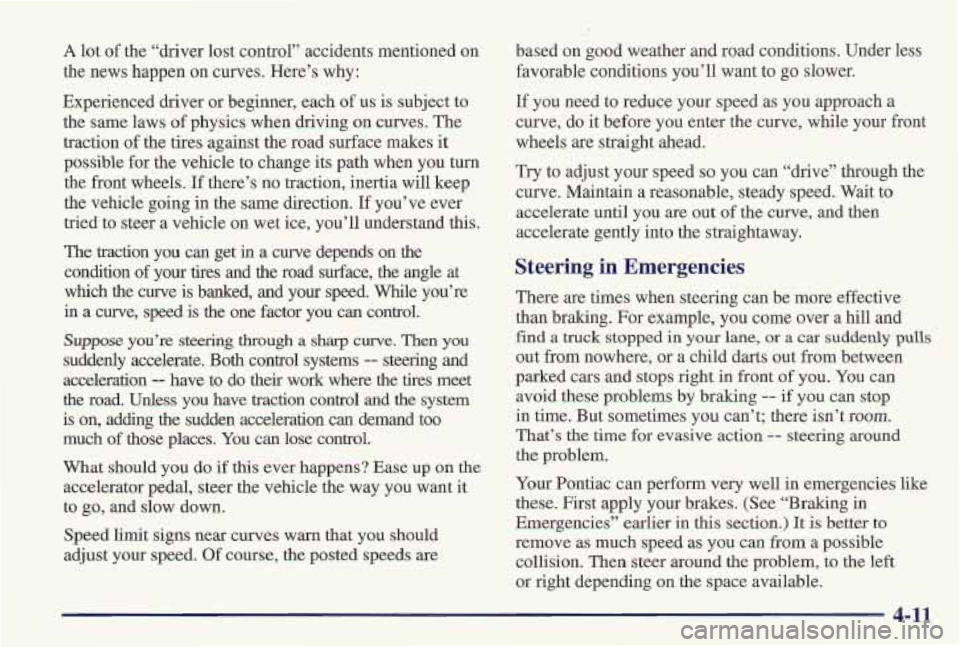
A lot of the “driver lost control” accidents mentioned on
the news happen on curves. Here’s why:
Experienced driver or beginner, each
of us is subject to
the same laws of physics when driving on curves. The
traction
of the tires against the road surface makes it
possible for the vehicle to change its path when you turn
the front wheels. If there’s no traction, inertia will keep
the vehicle going in the same direction. If you’ve ever
tried to steer a vehicle on wet ice, you’ll understand this.
The traction you can get in a curve depends on the
condition of your tires and the road surface, the angle at
which the curve is banked, and your speed. While you’re
in a curve, speed is
the one factor you can control.
Suppose you’re steering through a sharp curve. Then you
suddenly accelerate. Both control systems -- steering and
acceleration
-- have to do their work where the tires meet
the road. Unless you have traction control and the system
is on, adding the sudden acceleration can demand too
much of
those places. You can lose control.
What should you do if this ever happens? Ease up
on the
accelerator pedal, steer the vehicle the way you want it
to
go, and slow down.
Speed limit signs near curves warn that you should
adjust your speed. Of course, the posted speeds are based
on good weather and road conditions. Under less
favorable conditions you’ll want to go slower.
If you need to reduce your speed as you approach
a
curve, do it before you enter the curve, while your front
wheels are straight ahead.
Try to adjust your speed
so you can “drive” through the
curve. Maintain a reasonable, steady speed. Wait to
accelerate until you are out of the curve, and then
accelerate gently into the straightaway.
Steering in Emergencies
There are times when steering can be more effective
than braking. For example, you come over a hill and
find a truck stopped in your lane, or a car suddenly pulls
out from nowhere, or a child darts out from between
parked cars and stops right in front of you. You can
avoid these problems by braking
-- if you can stop
in time. But sometimes you can’t; there isn’t
room.
That’s the time for evasive action -- steering around
the problem.
Your Pontiac can perform very well in emergencies like
these. First apply your brakes. (See “Braking in
Emergencies” earlier in this section.)
It is better to
remove as much speed as you can from a possible
collision. Then steer around the problem,
to the left
or right depending on the space available.
4-11
Page 179 of 410
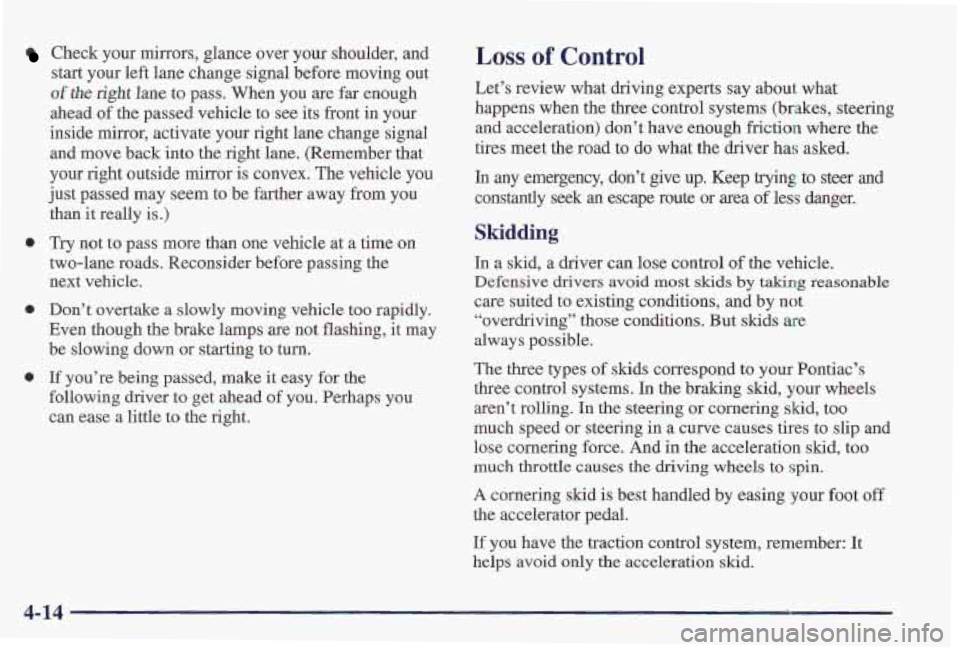
Check your mirrors, glance over your shoulder, and
start your left lane change signal before moving out
of the right lane to pass. When you are far enough
ahead
of the passed vehicle to see its front in your
inside mirror, activate your right lane change signal
and move back into the right lane. (Remember that
your right outside mirror is convex. The vehicle
you
just passed may seem to be farther away from you
than it really is.)
0 Try not to pass more than one vehicle at a time on
two-lane roads. Reconsider before passing the
next vehicle.
0 Don’t overtake a slowly moving vehicle too rapidly.
Even though the brake lamps
are not flashing, it may
be slowing down or starting to turn.
0 If you’re being passed, make it easy for the
following driver to get ahead
of you. Perhaps you
can ease a little to
the right.
Loss of Control
Let’s review what driving experts say about what
happens when the three control systems (brakes, steering
and acceleration) don’t have enough friction where the
tires meet the road to do what the driver has asked.
In any emergency, don’t give up. Keep trying to steer and
constantly seek an escape route or area of less danger.
Skidding
In a skid, a driver can lose control of the vehicle.
Defensive drivers avoid most skids by taking reasonable
care suited to existing conditions, and by not
“overdriving” those conditions. But skids are
always possible.
The three types of skids correspond
to your Pontiac’s
three control systems. In the braking skid, your wheels
aren’t rolling. In the steering or cornering skid, too
much speed or steering in a curve causes tires to slip and
lose cornering force. And in
the acceleration skid, too
much throttle causes the driving wheels to spin.
A cornering skid
is best handled by easing your foot off
the accelerator pedal.
If
you have the traction control system, remember: It
helps avoid only the acceleration skid.
4-14